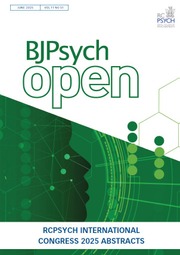Crossref Citations
This article has been cited by the following publications. This list is generated based on data provided by
Crossref.
Hadjistavropoulos, H.D.
Nugent, M.M.
Alberts, N.M.
Staples, L.
Dear, B.F.
and
Titov, N.
2016.
Transdiagnostic Internet-delivered cognitive behaviour therapy in Canada: An open trial comparing results of a specialized online clinic and nonspecialized community clinics.
Journal of Anxiety Disorders,
Vol. 42,
Issue. ,
p.
19.
Axelsson, Erland
Lindsäter, Elin
Ljótsson, Brjánn
Andersson, Erik
and
Hedman-Lagerlöf, Erik
2017.
The 12-item Self-Report World Health Organization Disability Assessment Schedule (WHODAS) 2.0 Administered Via the Internet to Individuals With Anxiety and Stress Disorders: A Psychometric Investigation Based on Data From Two Clinical Trials.
JMIR Mental Health,
Vol. 4,
Issue. 4,
p.
e58.
Hobbs, Megan J.
Mahoney, Alison E.J.
and
Andrews, Gavin
2017.
Integrating iCBT for generalized anxiety disorder into routine clinical care: Treatment effects across the adult lifespan.
Journal of Anxiety Disorders,
Vol. 51,
Issue. ,
p.
47.
Nordgreen, Tine
Gjestad, Rolf
Andersson, Gerhard
Carlbring, Per
and
Havik, Odd E.
2018.
The implementation of guided Internet-based cognitive behaviour therapy for panic disorder in a routine-care setting: effectiveness and implementation efforts.
Cognitive Behaviour Therapy,
Vol. 47,
Issue. 1,
p.
62.
Norlund, Fredrika
Wallin, Emma
Olsson, Erik Martin Gustaf
Wallert, John
Burell, Gunilla
von Essen, Louise
and
Held, Claes
2018.
Internet-Based Cognitive Behavioral Therapy for Symptoms of Depression and Anxiety Among Patients With a Recent Myocardial Infarction: The U-CARE Heart Randomized Controlled Trial.
Journal of Medical Internet Research,
Vol. 20,
Issue. 3,
p.
e88.
Andrews, G.
Basu, A.
Cuijpers, P.
Craske, M.G.
McEvoy, P.
English, C.L.
and
Newby, J.M.
2018.
Computer therapy for the anxiety and depression disorders is effective, acceptable and practical health care: An updated meta-analysis.
Journal of Anxiety Disorders,
Vol. 55,
Issue. ,
p.
70.
Kouvonen, Anne
Mänty, Minna
Harkko, Jaakko
Sumanen, Hilla
Konttinen, Hanna
Lahti, Jouni
Pietilainen, Olli
Blomgren, Jenni
Tuovinen, Eevamaija
Ketonen, Eeva-Leena
Stenberg, Jan-Henry
Donnelly, Michael
Sivertsen, Børge
Mittendorfer-Rutz, Ellenor
Pirkola, Sami
Rahkonen, Ossi
and
Lallukka, Tea
2019.
Effectiveness of internet-delivered cognitive behavioural therapy in reducing sickness absence among young employees with depressive symptoms: study protocol for a large-scale pragmatic randomised controlled trial.
BMJ Open,
Vol. 9,
Issue. 10,
p.
e032119.
Apolinário-Hagen, Jennifer
2019.
Internet-Delivered Psychological Treatment Options for Panic Disorder: A Review on Their Efficacy and Acceptability.
Psychiatry Investigation,
Vol. 16,
Issue. 1,
p.
37.
Hauffman, Anna
Alfonsson, Sven
Bill‐Axelson, Anna
Bergkvist, Leif
Forslund, Marina
Mattsson, Susanne
von Essen, Louise
Nygren, Peter
Igelström, Helena
and
Johansson, Birgitta
2020.
Cocreated internet‐based stepped care for individuals with cancer and concurrent symptoms of anxiety and depression: Results from the U‐CARE AdultCan randomized controlled trial.
Psycho-Oncology,
Vol. 29,
Issue. 12,
p.
2012.
Stech, Eileen P.
Grierson, Ashlee B.
Chen, Aileen Z.
Sharrock, Maria J.
Mahoney, Alison E.J.
and
Newby, Jill M.
2020.
Intensive one-week internet-delivered cognitive behavioral therapy for panic disorder and agoraphobia: A pilot study.
Internet Interventions,
Vol. 20,
Issue. ,
p.
100315.
Domhardt, Matthias
Letsch, Josefine
Kybelka, Jonas
Koenigbauer, Josephine
Doebler, Philipp
and
Baumeister, Harald
2020.
Are Internet- and mobile-based interventions effective in adults with diagnosed panic disorder and/or agoraphobia? A systematic review and meta-analysis.
Journal of Affective Disorders,
Vol. 276,
Issue. ,
p.
169.
Etzelmueller, Anne
Vis, Christiaan
Karyotaki, Eirini
Baumeister, Harald
Titov, Nickolai
Berking, Matthias
Cuijpers, Pim
Riper, Heleen
and
Ebert, David Daniel
2020.
Effects of Internet-Based Cognitive Behavioral Therapy in Routine Care for Adults in Treatment for Depression and Anxiety: Systematic Review and Meta-Analysis.
Journal of Medical Internet Research,
Vol. 22,
Issue. 8,
p.
e18100.
Hadjistavropoulos, H.D.
Peynenburg, V.
Thiessen, D.L.
Nugent, M.
Adlam, K.
Owens, K.M.B.
Karin, E.
Dear, B.F.
and
Titov, N.
2020.
A pragmatic factorial randomized controlled trial of transdiagnostic internet-delivered cognitive behavioural therapy: Exploring benefits of homework reflection questionnaires and twice-weekly therapist support.
Internet Interventions,
Vol. 22,
Issue. ,
p.
100357.
Stech, Eileen P.
Chen, Aileen Z.
Sharrock, Maria J.
Grierson, Ashlee B.
Upton, Emily L.
Mahoney, Alison E.J.
Grisham, Jessica R.
and
Newby, Jill M.
2021.
Internet-delivered exposure therapy versus internet-delivered cognitive behavioral therapy for panic disorder: A pilot randomized controlled trial.
Journal of Anxiety Disorders,
Vol. 79,
Issue. ,
p.
102382.
Efron, Gene
and
Wootton, Bethany M.
2021.
Remote cognitive behavioral therapy for panic disorder: A meta-analysis.
Journal of Anxiety Disorders,
Vol. 79,
Issue. ,
p.
102385.
Ebenfeld, Lara
Lehr, Dirk
Ebert, David Daniel
Kleine Stegemann, Stefan
Riper, Heleen
Funk, Burkhardt
and
Berking, Matthias
2021.
Evaluating a Hybrid Web-Based Training Program for Panic Disorder and Agoraphobia: Randomized Controlled Trial.
Journal of Medical Internet Research,
Vol. 23,
Issue. 3,
p.
e20829.
Pauley, Darin
Cuijpers, Pim
Papola, Davide
Miguel, Clara
and
Karyotaki, Eirini
2021.
Two decades of digital interventions for anxiety disorders: a systematic review and meta-analysis of treatment effectiveness.
Psychological Medicine,
p.
1.
Bendig, Eileen
Bauereiß, Natalie
Buntrock, Claudia
Habibović, Mirela
Ebert, David Daniel
and
Baumeister, Harald
2021.
Lessons learned from an attempted randomized-controlled feasibility trial on “WIDeCAD” - An internet-based depression treatment for people living with coronary artery disease (CAD).
Internet Interventions,
Vol. 24,
Issue. ,
p.
100375.
Hadjistavropoulos, Heather D
McCall, Hugh C
Thiessen, David L
Huang, Ziyin
Carleton, R Nicholas
Dear, Blake F
and
Titov, Nickolai
2021.
Initial Outcomes of Transdiagnostic Internet-Delivered Cognitive Behavioral Therapy Tailored to Public Safety Personnel: Longitudinal Observational Study.
Journal of Medical Internet Research,
Vol. 23,
Issue. 5,
p.
e27610.
Hadjistavropoulos, Heather D.
Peynenburg, Vanessa
Thiessen, David L.
Nugent, Marcie
Karin, Eyal
Staples, Lauren
Dear, Blake F.
and
Titov, Nickolai
2022.
Utilization, Patient Characteristics, and Longitudinal Improvements among Patients from a Provincially Funded Transdiagnostic Internet-delivered Cognitive Behavioural Therapy Program: Observational Study of Trends over 6 Years.
The Canadian Journal of Psychiatry,
Vol. 67,
Issue. 3,
p.
192.


eLetters
No eLetters have been published for this article.